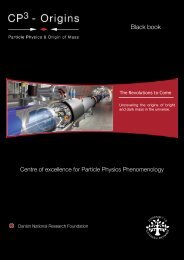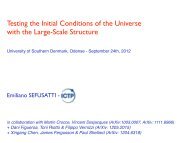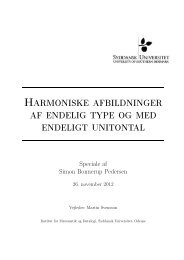2nd Black Book - CP3-Origins
2nd Black Book - CP3-Origins
2nd Black Book - CP3-Origins
You also want an ePaper? Increase the reach of your titles
YUMPU automatically turns print PDFs into web optimized ePapers that Google loves.
Roadmap and New Strong Forces of Nature<br />
The centre is designed to cover, during its lifetime, strategic areas of research orbiting around<br />
the fundamental problem of the “Origin of Mass” which is the “trait d’union” connecting them:<br />
• Electroweak Symmetry Breaking/Model Building<br />
• Dynamical Origin of Dark Matter and Inflation<br />
• Strong Interactions<br />
In the following we review the research we have been involved in during the reporting period.<br />
We plan to further extend our line or research below for the coming reporting year according to<br />
the original work-plan and milestones.<br />
Two staff members per research area will be the primary investigators according to their expertise.<br />
We expect to involve two postdocs per area of research. There is sufficient flexibility within<br />
this research structure to allow for the young researchers to pick the topic(s) which best suits<br />
their interests. Within each research project introduced below we present the methodological<br />
approach we will employ to achieve our goals.<br />
It is important to mention that shortly after the inaugural collisions, a number of new important<br />
experimental results were published independently by the ATLAS and CMS collaborations setting<br />
important constraints on extensions of the Standard Model. A relevant result is that certain<br />
theoretically constrained versions of the Minimal Supersymmetric Standard Model are showing<br />
tension with the experimental results. Interestingly our recent (of Dynamical Electroweak<br />
Symmetry Breaking type) and novel extensions (via magnetic duals) of the Standard Model are<br />
still top runners for discovery at CERN. We are looking forward to future experimental releases<br />
of data from the CERN experiments!<br />
Quantum Chromo Dynamics (QCD), the theory of “strong interactions”, constitutes one of the<br />
pillars of the Standard Model of particle interactions. It is responsible for the very existence of<br />
ordinary matter while leading to an extremely rich and interesting phenomenology ranging<br />
from the physics of the nucleus to the dynamics and composition of compact astrophysical objects<br />
such as neutron stars.<br />
Several experiments worldwide, existing and planned, such as LHC (CERN Geneva), DAΦNE<br />
(LNF Frascati), FAIR (GSI Darmstadt), TJNAF (Newport News), BES-III/BEPCII (Beijing),<br />
MAMI (Mainz), ELSA (Bonn), Tevatron (Fermilab, USA), BaBar/PEP-II (SLAC USA), Belle/<br />
KEK-B(Tsukuba) and CLEO (Cornell), are designed to investigate its many phenomenological<br />
aspects. QCD is responsible for the dynamical origin of mass of protons and neutrons, constituting<br />
about four percent of the Universe, i.e. the visible part.<br />
Another fundamental property of QCD is that it drives the spontaneous breaking of the electroweak<br />
symmetry, even in the absence of the Higgs boson, with a contribution to the weak<br />
gauge boson masses of the order of thirty MeV. The QCD-driven Higgs mechanism led Weinberg<br />
and Susskind to propose that the Higgs mechanism could emerge from a new strongly interacting<br />
theory, called Technicolor. The techni-hadronic scale should then be approximately<br />
one thousand times bigger than the QCD one, in order to accommodate for the experimental<br />
value of the weak gauge bosons masses.<br />
16 CP³-<strong>Black</strong> book








